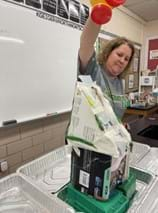
Summary
Students create and design leakproof, sustainable roofs inspired by UN Sustainable Development Goals (SDGs). Students use the engineering design process to create roof models with recyclable materials that withstand simulated rainfall, targeting SDG 3 (Good Health) and SDG 11 (Sustainable Communities). This project-based activity includes research on Ghana’s environmental challenges and promotes teamwork, design iteration, and global problem-solving through real-world engineering applications.Engineering Connection
As an architectural engineer, you can design functional and aesthetic lighting solutions, create buildings prepared to withstand earthquakes and other natural disasters, or invent affordable green technology to heat, cool, and power buildings with energy from the sun.
Structural engineers must be familiar with the geology of the area in which they are working. They must also take into consideration the type, size, and porosity of the rocks and presence of groundwater. Soil erosion and depositions by surface water are integral for soil conservation and sustainability.
Learning Objectives
After this activity, students should be able to:
- Identify sustainability issues in Ghana with regard to recycling and repurposing available resources and materials.
- Explain the materials available to the people of Ghana, and how they can be used.
- Use the engineering design process to construct a roof to fit a premade structure that keeps water from entering the dwelling.
Educational Standards
Each TeachEngineering lesson or activity is correlated to one or more K-12 science,
technology, engineering or math (STEM) educational standards.
All 100,000+ K-12 STEM standards covered in TeachEngineering are collected, maintained and packaged by the Achievement Standards Network (ASN),
a project of D2L (www.achievementstandards.org).
In the ASN, standards are hierarchically structured: first by source; e.g., by state; within source by type; e.g., science or mathematics;
within type by subtype, then by grade, etc.
Each TeachEngineering lesson or activity is correlated to one or more K-12 science, technology, engineering or math (STEM) educational standards.
All 100,000+ K-12 STEM standards covered in TeachEngineering are collected, maintained and packaged by the Achievement Standards Network (ASN), a project of D2L (www.achievementstandards.org).
In the ASN, standards are hierarchically structured: first by source; e.g., by state; within source by type; e.g., science or mathematics; within type by subtype, then by grade, etc.
NGSS: Next Generation Science Standards - Science
| NGSS Performance Expectation | ||
|---|---|---|
|
MS-ESS3-3. Apply scientific principles to design a method for monitoring and minimizing a human impact on the environment. (Grades 6 - 8) Do you agree with this alignment? |
||
| Click to view other curriculum aligned to this Performance Expectation | ||
| This activity focuses on the following Three Dimensional Learning aspects of NGSS: | ||
| Science & Engineering Practices | Disciplinary Core Ideas | Crosscutting Concepts |
| Apply scientific principles to design an object, tool, process or system. Alignment agreement: | Human activities have significantly altered the biosphere, sometimes damaging or destroying natural habitats and causing the extinction of other species. But changes to Earth's environments can have different impacts (negative and positive) for different living things. Alignment agreement: | Relationships can be classified as causal or correlational, and correlation does not necessarily imply causation. Alignment agreement: The uses of technologies and any limitations on their use are driven by individual or societal needs, desires, and values; by the findings of scientific research; and by differences in such factors as climate, natural resources, and economic conditions. Thus technology use varies from region to region and over time.Alignment agreement: |
| NGSS Performance Expectation | ||
|---|---|---|
|
MS-ETS1-1. Define the criteria and constraints of a design problem with sufficient precision to ensure a successful solution, taking into account relevant scientific principles and potential impacts on people and the natural environment that may limit possible solutions. (Grades 6 - 8) Do you agree with this alignment? |
||
| Click to view other curriculum aligned to this Performance Expectation | ||
| This activity focuses on the following Three Dimensional Learning aspects of NGSS: | ||
| Science & Engineering Practices | Disciplinary Core Ideas | Crosscutting Concepts |
| Define a design problem that can be solved through the development of an object, tool, process or system and includes multiple criteria and constraints, including scientific knowledge that may limit possible solutions. Alignment agreement: | The more precisely a design task's criteria and constraints can be defined, the more likely it is that the designed solution will be successful. Specification of constraints includes consideration of scientific principles and other relevant knowledge that is likely to limit possible solutions. Alignment agreement: | All human activity draws on natural resources and has both short and long-term consequences, positive as well as negative, for the health of people and the natural environment. Alignment agreement: The uses of technologies and any limitations on their use are driven by individual or societal needs, desires, and values; by the findings of scientific research; and by differences in such factors as climate, natural resources, and economic conditions.Alignment agreement: |
| NGSS Performance Expectation | ||
|---|---|---|
|
MS-ETS1-2. Evaluate competing design solutions using a systematic process to determine how well they meet the criteria and constraints of the problem. (Grades 6 - 8) Do you agree with this alignment? |
||
| Click to view other curriculum aligned to this Performance Expectation | ||
| This activity focuses on the following Three Dimensional Learning aspects of NGSS: | ||
| Science & Engineering Practices | Disciplinary Core Ideas | Crosscutting Concepts |
| Evaluate competing design solutions based on jointly developed and agreed-upon design criteria. Alignment agreement: | There are systematic processes for evaluating solutions with respect to how well they meet the criteria and constraints of a problem. Alignment agreement: | |
| NGSS Performance Expectation | ||
|---|---|---|
|
MS-ETS1-3. Analyze data from tests to determine similarities and differences among several design solutions to identify the best characteristics of each that can be combined into a new solution to better meet the criteria for success. (Grades 6 - 8) Do you agree with this alignment? |
||
| Click to view other curriculum aligned to this Performance Expectation | ||
| This activity focuses on the following Three Dimensional Learning aspects of NGSS: | ||
| Science & Engineering Practices | Disciplinary Core Ideas | Crosscutting Concepts |
| Analyze and interpret data to determine similarities and differences in findings. Alignment agreement: | There are systematic processes for evaluating solutions with respect to how well they meet the criteria and constraints of a problem. Alignment agreement: Sometimes parts of different solutions can be combined to create a solution that is better than any of its predecessors.Alignment agreement: Although one design may not perform the best across all tests, identifying the characteristics of the design that performed the best in each test can provide useful information for the redesign process—that is, some of the characteristics may be incorporated into the new design.Alignment agreement: | |
| NGSS Performance Expectation | ||
|---|---|---|
|
MS-ETS1-4. Develop a model to generate data for iterative testing and modification of a proposed object, tool, or process such that an optimal design can be achieved. (Grades 6 - 8) Do you agree with this alignment? |
||
| Click to view other curriculum aligned to this Performance Expectation | ||
| This activity focuses on the following Three Dimensional Learning aspects of NGSS: | ||
| Science & Engineering Practices | Disciplinary Core Ideas | Crosscutting Concepts |
| Develop a model to generate data to test ideas about designed systems, including those representing inputs and outputs. Alignment agreement: | Models of all kinds are important for testing solutions. Alignment agreement: The iterative process of testing the most promising solutions and modifying what is proposed on the basis of the test results leads to greater refinement and ultimately to an optimal solution.Alignment agreement: | |
Materials List
Each group needs:
- 1 small cardboard box
- 1 rectangular or square plastic tub (10-inch x 10-inch or bigger)
- 1 pair of scissors
- 1 hot glue gun
- 5 hot glue gun glue sticks
- 1 roll of masking tape
- 1 liquid glue
- 1 glue stick
- 1 sticky note pad
- 1 poster-size sticky note
To be shared with the class:
- craft sticks (if needed for making the housing structure), at least one box of at least 200, any size
- 1 5-pound bag of rock pebbles
- 1 5-pound bag of sand
- 2 2-pound bags of modeling clay
- 1 watering can
Worksheets and Attachments
Visit [www.teachengineering.org/activities/view/uod-2846-raise-roof-engineering-leakproof-roofs-activity] to print or download.Pre-Req Knowledge
Students should be familiar with the concept of recycling.
Students should be familiar with the steps of the engineering design process.
Introduction/Motivation
Who has heard of the United Nations sustainable development goals (SDG)? The SDGs are a globally adopted set of standards for each country to meet more sustainable universal standards. There are 17 world SDGs.
The short titles of the 17 SDGs are: No Poverty (SDG 1), Zero Hunger (SDG 2), Good Health and Well-Being (SDG 3), Quality Education (SDG 4), Gender Equality (SDG 5), Clean Water and Sanitation (SDG 6), Affordable and Clean Energy (SDG 7), Decent Work and Economic Growth (SDG 8), Industry, Innovation, and Infrastructure (SDG 9), Reduced Inequalities (SDG 10), Sustainable Cities and Communities (SDG 11), Responsible Consumption and Production (SDG 12), Climate Action (SDG 13), Life Below Water (SDG 14), Life on Land (SDG 15), Peace, Justice, and Strong Institutions (SDG 16), and Partnerships for the Goals (SDG 17).
The SDGs were created with the aim of "peace and prosperity for people and the planet," while tackling climate change and working to preserve oceans and forests. The SDGs highlight the connections between the environmental, social, and economic aspects of sustainable development. Sustainability is at the center of the SDGs.
In this activity, you all are going to become global engineers. Our global context is looking at the need for the sustainable use of materials in building roofs that would work for homes in Ghana. This would meet SDG Goal 3: Good Health and Wellbeing and SDG Goal 11: Sustainable Cities and Communities.
Where is Ghana? Ghana is a developing country in West Africa. What issues do Ghanaians face? One issue is pollution and recycling. The country is currently developing a recycling program with the SDGs in mind, especially in schools. Currently, Ghana combines its recycling and landfill materials, and they sort the recyclable materials after the combined trash is picked up, unlike how we separate items before going to the landfill in the United States. Access to clean water is another challenge, so one-use plastic water bottles and eating utensils are universally used.
According to an article by the United Nations Development Program, “In Ghana, about 12,710 tons of solid waste is generated every day, with only 10 percent collected and disposed of properly. Plastic waste constitutes a large proportion of urban waste” (Afriyie, K. & Lusigi, A. “Ghana Tackles Urban Waste Management.” United Nations Development Program, 11 October 2023. https://www.undp.org/blog/ghana-tackles-urban-waste-management).
Expensive building materials are another issue faced by Ghanaians. There are also a variety of house structures in Ghana, and building a solid roof structure to protect from the elements is important for the health of those inhabiting it. How can those living there use materials that are easily accessible and sustainable while still maintaining good housing conditions?
With this knowledge, we want to use the human-centered engineering design process to think of creative solutions for these real-world problems. So, let’s get started. Our engineering challenge is this: How do we create a roof using natural resources and sustainable materials? How can this help others, and ourselves?
Procedure
Background
The motivation for this activity is to incorporate the engineering design process with UN sustainable development goals. The SDGs are a globally adopted set of standards for each country to meet more sustainable universal standards. It is pertinent that students have exposure to global competency. We want our students to be able to have experiences in STEM that tie in an interdisciplinary component that encourages their participation in a globalized world. Students will use the engineering design process through a project-based learning mindset in this activity.
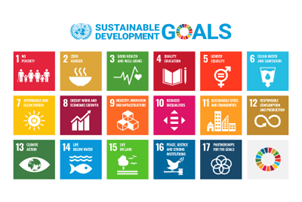
The 2030 Agenda for Sustainable Development, adopted by all United Nations members in 2015, created 17 world Sustainable Development Goals (SDGs). They were created with the aim of "peace and prosperity for people and the planet," while tackling climate change and working to preserve oceans and forests. The SDGs highlight the connections between the environmental, social, and economic aspects of sustainable development. Sustainability is at the center of the SDGs.
The short titles of the 17 SDGs are: No Poverty (SDG 1), Zero Hunger (SDG 2), Good Health and Well-Being (SDG 3), Quality Education (SDG 4), Gender Equality (SDG 5), Clean Water and Sanitation (SDG 6), Affordable and Clean Energy (SDG 7), Decent Work and Economic Growth (SDG 8), Industry, Innovation, and Infrastructure (SDG 9), Reduced Inequalities (SDG 10), Sustainable Cities and Communities (SDG 11), Responsible Consumption and Production (SDG 12), Climate Action (SDG 13), Life Below Water (SDG 14), Life on Land (SDG 15), Peace, Justice, and Strong Institutions (SDG 16), and Partnerships for the Goals (SDG 17).
These goals are ambitious, and the reports and outcomes to date indicate a challenging path. Most, if not all, of the goals are unlikely to be met by 2030. Rising inequality, climate change, and loss of biodiversity are topics of concern threatening progress. The COVID-19 pandemic from 2020 to 2023 made these challenges worse. The pandemic impacted all 17 goals and emphasized the interconnectedness of global health, economic, social, and environmental challenges. Some regions, such as Asia, have experienced significant setbacks during that time. The global effort for the SDGs calls for prioritizing environmental sustainability, understanding the indivisible nature of the goals, and seeking synergies across sectors.
The global context for this activity is to look at the need for the sustainable use of materials in building roofs that would work for Ghanaian homes. This would meet SDG Goal 3: Good Health and Wellbeing and SDG Goal 11: Sustainable Cities and Communities.
Ghana is located on the west coast of Africa and is bordered by Côte d’Ivoire, Burkina Faso, and Togo. The Atlantic Ocean lies to the south. Ghana’s climate is warm year-round, with dry and rainy seasons. Ghana’s land is mainly flat. The southwest, northwest, and north contain higher plateaus and some hills and valleys. Low mountain peaks rise in the east.
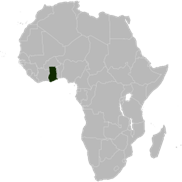
There are a variety of house structures in Ghana, and building a solid roof structure to protect from the elements is important for the health of those inhabiting it. However, building materials are expensive!
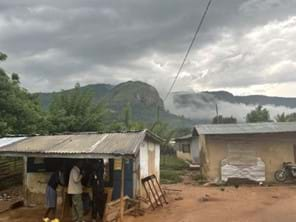
We want to encourage students to use the human-centered engineering design process to think of creative solutions for real-world problems. This activity allows students to research a different country and compare/contrast it to their own environment. We want to encourage students to work in a group setting to problem solve ideas that we face in our own communities and work together to solve issues in a global context, as well.
Before the Activity
- Have a brief discussion with the class regarding recyclable materials they find in their homes, such as cereal boxes, aluminum cans, boxes, etc. Have them begin collecting and bringing these items to class to store for the activity.
- Cut up the recyclable materials into smaller pieces to simulate shingles on a roof.
- Glue together one housing structure (without the roof) per group. Build a few of each type of roof: flat, lean-to, and gable. You can do this by gluing together pieces of cardboard. Be sure the structure has at least one opening and is no bigger than 6 inches by 6 inches.
With the Students
Part 1 (Introduction)
- Have the students answer the Raise the Roof Pre-Assessment.
- Read through the Introduction / Motivation section.
- Present the Intro to Raise the Roof Presentation to the class. Make sure to hit upon these discussion points:
- How do economically advantaged people live?
- How do economically disadvantaged people live?
- Compare their living accommodations to how you live.
- Do you have a roof over your head?
- What is your roof made from?
- Have you ever had a problem with the roof of your home?
- Remind the students about the recycling discussion held previously.
- (Optional) Review the engineering design process.
- Ask: Present the driving question: Can we create a leakproof and sustainable roof utilizing resources available in the country of Ghana?
- Split class into groups of 3-4 students.
- Give one Raise the Roof Challenge sheet to each group.
- Go through the Raise the Roof Challenge with the students.
Part 2 (Research and Imagine)
- Give one Raise the Roof Research Worksheet to each student.
- Research: Have students research questions 1-6 on the Raise the Roof Research Worksheet and answer the questions. (Or assign the research as homework.)
- Have students ask questions about what they will need to know to complete the activity. For example:
- What resources are available in the country of Ghana?
- Imagine: Have each student draw out a possible prototype (question 7 in the Raise the Roof Research Worksheet), then discuss in a group the pros and cons of each design that the students came up with.
Part 3 (Plan, Create / Build)
- Plan: Have the students choose one of their prototypes. Have each group draw their chosen prototype on a poster size sticky note. Have students post their prototype sticky note on the wall.
- Gallery Walk:
- Have each group share their chosen prototype in a gallery walk to garner feedback from their peers.
- Have students walk around the room and leave feedback on sticky notes for each prototype. Each student should leave two pieces of feedback:
- I like…
- I wonder…
- Create / Build: After receiving feedback from their peers, have each group build chosen roof prototype.
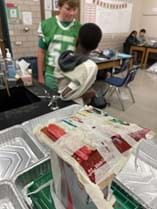
Part 4 (Test)
- Test: Have groups test their roof prototype by placing the roof on the premade structure in a tray and using a watering can filled with one quart of water to simulate the rainy season. The students will measure how much water was poured onto the roof before the roof started to change shape. The water is to sit on the structure for five minutes to be sure the structure of the roof remains intact without leaking. Be sure to place something underneath the structure being tested to avoid the cardboard sitting in water.

- Test / Improve: Have students participate in a feedback protocol called Tuning Protocol.
- Have the students get into groups of 2-4. Be sure that the students are not in their roof group.
- Student A will review with the other group members what happened to their roof when it was being tested (2 minutes). Participating students will take notes while Student A is presenting.
- Participating students will write down feedback on sticky notes according to the teacher’s direction. For example, one I like… feedback statement and one I wonder… feedback statement (1 minute).
- Participating students then share their feedback with Student A while Student A just listens (2 minutes).
- Have an open discussion about the feedback (2 minutes).
- Switch students and repeat the protocol until all the students have shared and received feedback.
- The students will then complete a redesign of the roof.
Part 5 (Improve)
- Improve: Let student groups complete a design of their roof prototype.
- Have students retest their redesigned roof.
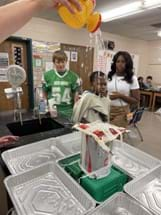
- Have students answer the Reflection Worksheet.
Vocabulary/Definitions
flat roof: A roof that is almost level, in contrast to the many types of sloped roofs.
gable roof: A roof consisting of two sections whose upper horizontal edges meet to form its ridge.
Ghana: The second-most populous country in West Africa.
hut: A small, simple, single-story house or shelter.
lean-to roof: Also known as a shed roof, a type of roof that is sloped in one direction, typically attached to the side of a building.
sustainability: The ability to maintain or support a process over time.
Assessment
Pre-Activity Assessment
Students fill out the Raise the Roof Pre-Assessment.
- What is the purpose of a roof on a house?
- What features do roofs have that keep water out?
- Why would we not want water in our houses?
- What items are typically recycled, and what are some examples of recycled materials that can be found in the house?
Activity Embedded Assessment
Have students answer the Raise the Roof Research Worksheet.
- Look up Ghana. Where is it located?
- What materials are the roofs built from in the U.S. and in Ghana?
- What is a common sustainability issue in the country of Ghana?
- What are three types of rocks in the country of Ghana?
Summative Assessment
- Use the engineering design process to construct a roof out of provided rocks, sediments, and recycled materials that keeps the inside of the hut dry.
Post-Activity Assessment
- Students complete the activity. Teacher uses Raise the Roof Rubric to assess.
- Students complete the Reflection Worksheet.
- How were you able to determine the sustainability issues in the country of Ghana?
- What materials did the initial prototype of your roof consist of?
- What materials did the final product consist of, and why?
- What did you learn during this process?
- If you had to do it all over again, what would you change?
- What issue does this activity help to solve?
Activity Extensions
Students who need a challenge/get done early can research the SDG goals and consider which ones apply most to their project.
Video Demonstration:
Subscribe
Get the inside scoop on all things TeachEngineering such as new site features, curriculum updates, video releases, and more by signing up for our newsletter!Copyright
© 2024 by Regents of the University of Colorado; original © 2023 Central State University and University of DaytonContributors
Kristy Geiger, Jenn Stormer, Victoria Jacobs, Rae Ober; Marjorie LangstonSupporting Program
Global STEM Research Experience for Teachers (RET) — Appropriate Technology for Developing Communities, University of Dayton, Central State UniversityAcknowledgements
We would like to thank the following for their assistance on this work: Margaret Pinnell, Ph.D; Leanne Petry, Ph.D.; Kellie Schneider, Ph.D.; Amy Anderson, Ph.D; Kelly Bohrer; Suzanne Seleem, Ph.D; Sharath Krishna, Ph.D.; Rajeev Swami, Ph.D.; Dr. Denise Taylor, Ph.D.; Sharath Krishna, Ph.D.;Rydge Taylor, Ph.D.; Miranda van Iersel, Ph.D. (Note: Her last name starts with a capital "I".); Kevin Hallinan, Ph.D.; Andrew Chaisson, Ph.D.; Dave Perkins, Ph.D.; and Jacob Cress, Ph.D. This curriculum was developed under National Science Foundation RET grant number EEC. 1855231/1855239. Any opinions, findings, and conclusions or recommendations expressed in this material are those of the authors and do not necessarily reflect the views of the National Science Foundation.
Last modified: November 18, 2024








User Comments & Tips